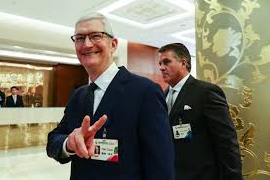Slaying of UnitedHealthcare CEO spotlights complex challenge companies face in protecting top brass

The Growing Challenges of Protecting Corporate Leaders: Insights from the UnitedHealthcare Tragedy

The tragic gunfire of UnitedHealthcare CEO Brian Thompson has cast attention on the complicated challenges businesses face in protecting their top managers. In an era where online aggression and societal stiffness frequently target corporate objects, safeguarding leaders need a balance of vigilance, technical advancement, and cultural thoughts. This article delves into the developing landscape of decision-making security, examining industry tendencies, the role of technology, and the implications for companies universally.
The Rising Threats Facing Business Executives
In recent years, CEOs have progressively become targets of societal prevention. Public anger furled by online dissertations, political unrest, and financial disparities often gets absorbed by the leaders of major corporations. For example, Meta CEO Mark Zuckerberg is synonymous with his company and spends substantial resources on personal safety. In 2023, Meta allocated an astounding $24.4 million to protect Zuckerberg, highlighting the heightened risks of high-profile best expression.

Contributing Factors to the Risk
- Public Recognition: CEOs closely associated with their companies, like Zuckerberg or Apple’s Tim Cook, often bear the brunt of public dissatisfaction.
- Digital Presence: The internet amplifies threats, providing platforms for individuals to vent frustrations or make direct threats.
- Economic Uncertainty: Financial challenges often exacerbate societal grievances, increasing hostility toward perceived decision-makers.

Read more actor Jack Veal appeals for help as he says he’s homeless at 17
Industry-Wide Concerns
Data from the National Safety Council reveals a troubling increase in workplace violence, with 525 fatalities in 2022 due to assaults. High-risk industries such as healthcare, education, and public services report higher incidences of violence, indicating a broader need for comprehensive safety measures.
How Companies Approach Executive Protection
Organizations adopt varied strategies for executive protection based on their size, industry, and risk profile. Some rely heavily on advanced security technologies, while others emphasize accessibility and transparency.
Spending Trends
- Tech Industry: Companies like Meta and Amazon lead in security expenditure, with Meta’s $24.4 million far surpassing others.
- Conservative Budgets: Apple spent $820,000 2023 for CEO security, reflecting a different risk assessment approach despite prior stalking incidents targeting Tim Cook.
- Median Investment: Fortune 500 companies report a median expenditure of $98,000 annually for CEO protection, doubling from three years ago.

| Company | Security Budget (2023) | Focus |
|---|---|---|
| Meta | $24.4 million | Comprehensive executive safety |
| Apple | $820,000 | Public appearances and home safety |
| Fortune 500 Avg. | $98,000 | Basic threat monitoring |
Leveraging Technology for Threat Detection
Technology integration in security operations has significantly enhanced the ability of companies to detect and mitigate risks. However, challenges persist in interpreting the data effectively.
Tools and Techniques
- AI and Machine Learning: These tools scan online platforms, including social media and the dark web, to identify potential threats.
- Digital Surveillance: Protective intelligence teams monitor conversations about their companies and executives to distinguish credible threats from mere venting.
- Security Checkpoints: High-profile events, such as Apple’s product launches, often require attendees to undergo stringent checks similar to airport security.
Limitations of Current Systems
While companies are adept at collecting signals, interpreting them remains complex. Many threats lack credibility, and distinguishing real dangers from idle talk requires skilled analysts and robust processes.

Balancing Accessibility with Safety
For some companies, maintaining open communication with shareholders, employees, and the public is integral to their culture. However, this can increase security risks.
Contrasting Approaches
- Virtual Meetings: Amazon holds shareholder meetings online, reducing physical risks.
- Public Accessibility: Companies like UnitedHealthcare prioritize in-person interactions, which can expose executives to unforeseen threats.
High-Risk Scenarios
Investor meetings are particularly vulnerable, as event details are often publicly available, giving potential attackers ample preparation time.
Lessons from the UnitedHealthcare Incident
Brian Thompson’s ambush underscores the unpredictable nature of executive threats. While many companies take proactive measures, this tragedy highlights the need for continuous evaluation and adaptation.
Key Takeaways
- Proactive Planning: Regular assessments of security strategies are essential.
- Cultural Sensitivity: Companies must balance safety with their leadership style and brand values.
- Increased Awareness: Incidents like Thompson’s shooting prompt executives across industries to reevaluate their security measures.
| Executive Security Tips | Details |
|---|---|
| Regular Risk Assessments | Conduct frequent reviews of potential threats and current protocols. |
| Invest in Technology | Leverage AI and digital tools for real-time threat detection. |
| Physical Safeguards | Employ trained personnel and robust event security measures. |
FAQs
What is the primary threat to corporate executives?
The main threat stems from online hostility, which can escalate into real-world actions. Due to their visibility, high-profile CEOs are particularly vulnerable.
How much do companies typically spend on executive security?
The median expenditure among Fortune 500 companies is $98,000 annually, though figures vary widely based on the company and executive profile.
Why do some companies choose not to invest heavily in security?
Some firms prioritize accessibility and transparency, believing that high-profile security may alienate stakeholders or conflict with their culture.
How can technology help in executive protection?
AI and machine learning tools monitor online platforms for potential threats, enabling early detection and mitigation.
What role do in-person events play in executive risks?
Public events like shareholder meetings pose higher risks due to their predictable nature, allowing attackers to plan in advance.
How should companies adapt after a security breach?
Firms should conduct thorough investigations, reassess protocols, and implement necessary changes to prevent future incidents.
Conclusion
The tragic demise of Brian Thompson helps as a sobering reminder of the multifaceted security challenges business leaders face today. In an era, noticeable by societal tensions and numerical transparency, businesses must continuously adapt their plans to protect executives deprived of compromising their standards. By investing in progressive technology, fostering social consciousness, and maintaining proactive watchfulness, businesses can navigate these tests effectively while prioritizing safety for all investors.






